American Sabbatical 58: 12/1/96
Arizona
12/1.. Arizona.
| Our last day in San Diego was spent shooting the MATERIAL WORLD
photo of Red Owl and his contents. If you haven’t see the Sierra
Club book, it is a collection of photos of families around the
world, posed in front of their houses with all their material
possessions. Your homeless reporters spread their culch on their
camp tarp, and smiled at the camera. We still have too much stuff,
even with the limits of Festiva-ism.. all the backup discs for
the laptop, for example.. but we have a well-tested sense of autominimalism,
and it was an eyeopener to see our “essentials” all laid out. |
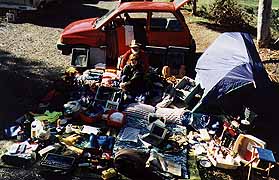
Owlers' Material World
|
Other essentials were laid bare in our parting conversations.
After two weeks, there weren’t many secrets left untold between
old friends, and those were pretty transparent. And I have to
wonder about the role of bygone companions in a mobile culture.
First we were immigrants who had left our homelands. Then we were
westering wanderers, ready to pull up stakes at the least rumor
of greener pastures. Now we are industrial nomads following the
whims of fortune or our imagined grails, wherever the trail leads.
Most casual friendships are too fragile to survive these transplantings,
and wither when they are no longer face-to-face. So the American
way is hard on enduring companionship.
But I’ve always believed that friends are for life. If friends
are those who bring out the best in you, then they are the necessary
mirrors to reveal what we can best be. Maybe they tell us who
we are. Friends become part of my life, and that’s of one piece,
not a serial chronology. I find it impossible to simply move on
to new intimacies and let old relationships die, and am surprised
that others find it easy. This journey has put my idealization
to the test.
It's been a joy to breeze into familiar lives and pick up where
we left off. Even 25 years hasn’t been long enough to create an
impassable strangeness with some old buddies. If we really knew
each other when, it’s easy to find the connecting threads. The
mutual recognition has reaffirmed our self-knowledge, and we’ve
danced the old friend dance. But what happens when a fondly remembered
part of you has gone off a deep end? Into an abyss you’ve looked
down into, but scrambled back from. Can you look into those eyes
and still see yourself? What responsibilities do you bear? Can
you just honor the old relationship by sharing nostalgic reminiscence,
without confronting today’s truth? But who are you to judge an
old friend’s behavior. Can you not become involved, when the face
in your mirror is haunted? And what can you do when home is a
continent away?
We thought this trip was a way to discover America and get a tangible
sense of our national history. We hadn’t anticipated that it would
recapitulate our personal histories through refound friends and
family, or that America would become an inner landscape.
There is still a lot of outer landscape between here and there.
Sunday at sunset I climbed the nearest hill in Encanto and looked
down onto the city center, watching a dirigible circling in the
yellow dazzle, and the smutch redden behind the steel towers.
Then I looked east, where naked conical peaks poke up out of the
settlements, promising dryer mountains beyond. From up there Encanto
has a hillcountry charm that I’d missed in the malcontent below.
If only everyone could climb a far hill and look down on their
troubles in a sunset light.
Monday morning we made our escape from far Diego, and wound the
Owl upcountry in fourth gear. It was fascinating to retrace my
trail to Anza Borrego after I’d written a log about it. Seeing
all I’d forgotten to describe, or got backwards. A sobering experience.
And we were all too sober, trying to let the tensions we had been
absorbing ebb away. It’s hard to see landmarks in the middle of
a storm, and the farther we got from the maelstrom, the clearer
our vision became.
The air was dry over the California desert, but there was a blessed
cover of high cumulus, so our eyes got a break. East of Ocatillo
the desert vegetation gets even more sparse, and when the first
irrigation plots of the Imperial Valley come alongside the contrast
is striking. The outermost plantations are mostly hayfields, green
alfalfa in leaf, piles of yellow bales out in the open. Northern
veggies appear, but most of the land is plowed barrenness in this
winter season. The temperature is only 65 degrees. Just as in
the Central Valley, we are surprised by the prevailing aridity.
You expect the vegetable basket of America to be humid and luxuriant.
But these foodstuffs are nurtured in an alien environment. Just
beyond the watered geometries the thin shrubbery turns to dunes.
Lawrence of Arabia meets John Deere.
Then we are across the Colorado, what’s left of it after thirsty
California, and into Yuma, Arizona. And the major landforms change
immediately. Sculpted solitary mountains and pleated purple massifs
stand up suddenly out of the flat desert. Arizona license-plate
maroon is the dominant color, while yellowgreen creosote bush
and silver cholla rule the flora. We jack the first side of a
book-on-tape into the noise machine and enter a state of dissonance.
VERTICAL RUN is a violent-action thriller that takes place in
a New York Office Tower, while we are locked into the highway
drone of a flat world. The mind’s eye and the reporter’s awareness
blur into one another. Are we sprinting up the firestairs, or
doing 75 between two semis? Occasionally the spell is broken by
agribiz in the unlikely. Miles of cotton, some looking very productive
with fat white bolls, most like raggedy lint caught in dead bushes.
In the vivid green patches beside irrigation canals egrets were
striding. High above, Air Force jets performed acrobatic maneuvers.
Then we were running down office corridors.
|
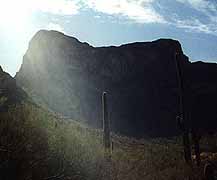
Arizona License
|
Desert winds had been pushing us around ever since we descended
out of the In-Ko-Pah, and as we easted occasional balls of tumbleweed
galloped with the dust. Oases with rattling palm trees loomed
and sped by, and snowbird estates, motorhome parks, sometimes
naked to the sun, sometimes with a few smoketrees for shade, swung
by. One palm cluster, a date plantation near the highway, had
an outlet store and takeout where they offered date-shakes. We
didn’t slurp.
|
Our audio adventure made time fly, and we’d been flogging the
Owl for 6 hours before we began to weary of the chase. We were
due in Tucson on Tuesday afternoon, and had thought to swing south
through the organpipe cactus country along the Mexican border,
but we doubted there were any motels that way, and we wanted a
place to hole-up and catch up on our puting. So we pushed on to
the nearest Super8, in Casa Grande. By the time we found it, the
skybeings were limbering up for one of those desert sunsets. Dawns
and dusks are simply spectacular in this dry skycountry, where
a bit of dust and a hundred miles conspire to paint the horizon
livid. A patch of thin clouds made a canvas for another one-dog
show, and purpleblack mountains stood around the edges of the
level landscape. We puted gladly til the fever left us.
| Tuesday awoke with another skyshow, sizzling yellow up the wall,
and we Owled out onto the warming flats, heading southeast for
Tucson. We’d left our audio hero hiding in the cablerun on the
14th floor, and he was soon dodging bullets in our ears. But we
shut him off quick when we entered an enchanted cactus-scape:
saguaro raising their prickly arms all around us. We swung off
the interstate and pulled into a byroad at the foot of Picacho
Peak to gawp in awe. An evenly spaced sea of sage and creosote
bush ran up the mountainsides, and towering above this undergrowth
the eloquent saguaro rose 15 to 20 feet high, each old master
(200 years or more we’re told) standing separately, 10 yards or
more apart. In the distance they looked like green spiny fingers
gesturing at the sky, all the way to the top of the mountain.
Closeup each swollen semaphore seemed to signal an ancient message
over our heads. We stayed and sketched until a park ranger shooed
us out of the road. |
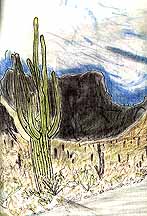
Picacho Peak
(Peggy)
|
We abandoned the fastlane again, next chance we got, climbed out
of the flats, and meandered through foothills covered in marching
armies of saguaro. And all their kin came to visit. Silver cholla,
with blossoming heads of prickleballs shining like metal, and
the articulated pad-sculptures of prickly-pears, along with barrels
and hedgehogs. The display grew denser as the byway wound up into
the Saguaro National Monument, until the pricklefest nearly hid
the shattered fragments of rocky ground. In among the elders and
their bristly kindred were winding tracks leading to campers and
shanties, and piratical types in beat pickups would appear here
and there giving us the onceover. Outlaw country. Felt like Bowdoinham.
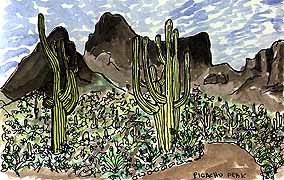
Picacho
(Bryce)
|
We pulled into a picnic area for bread and cheese under the shade
of green-skinned palo verde trees, then walked a circuit in Saguaroland.
One of the wonders of desert plants is that almost every one gets
to grow to its full symmetrical potential. Because of the arid
economy and the chemical warfare, the habit of every well-spaced
survivor is completely expressed. In a desert every plant, at
least, can be be totally himself. Is that what people seek in
a desert reclusion? |
We came out of our reclusion into the outskirts of Tucson with
or heads on the 48th floor. Seth had advised us to check out a
crafts mart on some numbered ave or street near Speedway, but
I’d forgotten the particulars, and we made a spiral approach through
the increasing urbanity, while our hero tried to outwit his pursuers.
When we finally lit on 4th where the street rastas were teaching
their puppies streetsmarts, and the skateboard kids were curbjumping
among the alternate boutiques, our blood was pumping from audio
running and traffic dodging. (Result of a short sample: Arizona
drivers have it all over Californians for sheer rudeness.) But
the shopkeepers are great, and Peggy was led to bolts of gaudy
Guatemalan fabrics and the silverwork she was seeking, while I
toured the kitsch collections: my favorites were dayglow desertscapes,
cactus critters, cholla-skeleton napkin rings, and Kokopeli playing
basketball.
Then it was almost time to arrive at Peggy’s step-cousin Judy’s
house, so we joined the cut-thoat traffic headed north and found
our way to her inner suburb. The southwest cities defy our eastern
categories. A metroglomeration rises up out of the big empty and
oozes out into the flatness in all directions. While there is
generally a core of skyscraping towers, most of the city structures
are one or two stories, with residential and commercial buildings
mixed together. The corner store may be a minimall: this is an
automotive universe, of course. So where the city ends and the
burb begins is moot. Tucson is a suburban burg, and Judy lives
down a quiet sidestreet off a throbbing artery. We sat on the
shoulder just shy of her house to listen to our hero make his
final escape from his highrise nightmare. Commuting to this stuff
must be difficult: you’d always be late for work.
Judy’s house is a modern desert dwelling on a single story, all
in rounded brightness and filled with light. I was entranced by
the yard. Tucson has stringent water conservation ordinances,
and this neighborhood doesn’t have lawns, it has cactus gardens.
Palms and other desert trees punctuate the scene, but the rest
is a jungle of agavi, yucca, saguaro, chollas, etc., with accenting
roses and bougainvillea still in bloom. This thorny, spiky, prickly
decor may spoil soccer for the neighborhood kids, but it creates
images of savage beauty I find irresistible.
Judy is fun to be with, too. As Peggy’s lone relative on her step-mother’s
side, she is an important part of Peggy’s self-understanding.
As girls and young women they were kept apart, in Zimi’s CIA-style
cellularity, and neither of them ever knew much about Zimi’s past.
Pooling their bits and pieces leads to fabulous conjectures, and
is a lesson in what happens to history when a party wants the
past forgotten. Sitting between them, I’m amused a how many mannerisms
and ways of thinking these two women share with their mystery
relative, acquired by nature (Judy), or by nurture (Peggy). It’s
a bit disconcerting to have so much of Zim in a room again.
We have to hurry back onto the road again in the morning, because
I’ve got a gallery meeting in Scottsdale Wednesday afternoon,
and our homeward pace is quickening. Peggy and Judy do manage
to get a desert walk together, while Judy’s husband George gives
me cuttings of various cacti. I’m dreaming of gravel and desertification
for the dooryard vs. all that greenstuff that needs mowing. How
the dogs will take to this is a good question. We watched rabbits
and quail feeding in the dawn prickleyard, and the dogs would
love the rabbits, I’m sure. As for the javalina and coyotes that
frequent this neighborhood, they weren’t offered for export. The
local woodpeckers feast on the cacti, but I wonder how long it
would take a Maine pecker to figure out the prickle-dance. I planted
the cuttings among our camping gear, and hope we don’t need to
pitch tent in the dark.
| Between Tucson and Phoenix the desert is almost unrelieved by
near mountains, and those saguaro close to the highway don’t look
healthy. We are told that road pollution is taking a toll on the
old giants, as it is on the Maine pines. The palo verde look lush,
however, and the brush and cholla are hostile enough to survive
anything. The plants get might thin in spots, and we are glad
it’s winter and in the 60’s, with some cloud cover. This must
be a harsh road in high sizzle. |
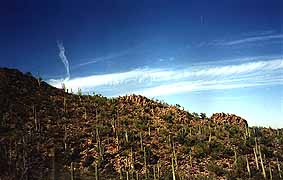
Saguaro
|
There was a yellow-brown smutch hanging above Tucson as we put
it over the horizon, and Phoenix is definitely rising from its
ashes, to judge by the smoky air. After LA, this city feels like
the biggest borough we’ve encountered, which may be because it
is so flat and you see so far over the megalop to the clusters
of commercial pride. And it's all so new. Sprung up overnight,
like Tucson. Phoenix seems to have the multi-centered qualities
of Los Angeles, and we pass through a number of sectional urbs
on our way to Scottsdale.
Unlike Tucson, which only has mountains standing on its periphery,
greater Phoenix has pale redstone mounts erupting occasionally
out of the gridded level. Scottsdale nestles on the northeast
side of some dramatic outcrops, and has all the stylish ambiance
of Beverly Hills. The gallery we are seeking is in an arts shopping
district of fashionable vendors, in a Spanish setting on mesquite-shaded
streets connected by brick-paved roundabouts.
I was distinctly put off by the ultra-posh and the German autos,
but the gallerians completely won me over. They were smitten by
my work (a quick way to my heart), and their shrewd business sensibility,
coupled with their esthetic insight, made them instant allies.
The works they had on show were a stunning collection, and the
place was full of soulful laughter. A place where sacred clowning
is welcome feels good to me. We made mutual pledges to conjure
up a show of Brycework in a year’s time. Feels good, folks, to
have found a possible pitch out here in the sunshine. We yahooed
to the Super8 in Tempe and swam laps in the balmy air. Then bubbled
in the Jacuzzi. Could we take more of this? Well, maybe. Even
the Mexican restaurant we were pointed at was one of those happy-staffed
places where the food was excellent, and cheap! Just goes to show.
I thought Phoenix was the pits when we were hustled in on the
rushrush, and now it seems rather charming, like a young wine
perhaps.




